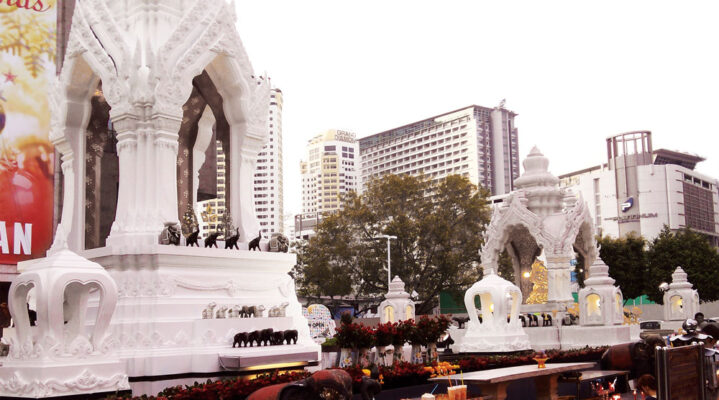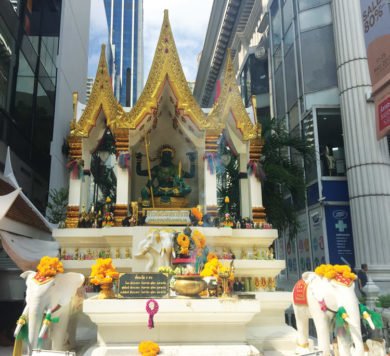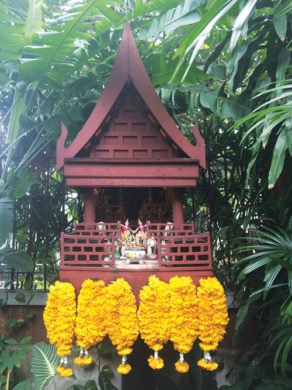
Spirit Houses and Shrines
Wandering around Thailand it is hard not to notice the spirit houses, which are present outside in the corner of almost every business, hotel, shopping mall, even in some people’s homes or maybe I should say their gardens? They are often elaborate in their design and are adorned with offerings from food and drink to flowers and fruit.

The Thai people are deeply spiritual and superstitious. 97% of Thais are Buddhist but a lot of their beliefs also stem from animism, a belief that natural objects possess souls and Hinduism. When a Thai buys a piece of land for development, before anything is done, a spirit house is erected to appease the land spirits. A doll’s house sized abode is built for the now homeless land spirits. Technically a Brahman monk will decide on an auspicious placing in the grounds for the spirit house, which should not lie in the shadow of the house nor disturb any auspicious tree.
Indeed, many Thai houses will be built around a tree that has special spiritual significance. Often such trees are also wrapped with ribbons and become a shrine themselves to the tree spirits. Often Thai’s passing spirit houses will wai to the land spirits who are represented inside the home with small figures and many office workers and home owners will leave offerings to keep the spirits happy, a kind of Thai you scratch my back and I will scratch yours. The fear in not keeping these spirits happy is that bad luck or bad karma afflicts those who do not respect the spirits.

There are 4 types of spirit house. San Jao Tii, which is the typical spirit house built for the spirits who occupy the land and tend to resemble old Thai houses with figures representing the land spirits ’living’ inside. San Pra Phoom is a home for the guardian angel that inhabits the land and is often built more in the style of a Thai temple. Reflecting the hierarchal nature of Hinduism, it stands higher and more grandly than the humbler San Jao Tii with a figurine of Phra Chai Mongkon, holding a sword in one hand and a bag of money, sitting inside alongside a motley crew of assembled characters. Also reflecting the higher standing of this spirit guardian, people may be seen praying in front of them and not just making merit.
San Phra Brahm is the larger style open sided spirit house often seen outside businesses and has the Hindu God of Creation, Pra Brahm inside. Pra Brahm is seen as being more auspicious and consequently these spirit houses become more shrine, such as The Erawan Shrine. San Piyanda is a temporary spirit house erected during the building stages of a project and generally used by the workmen to protect them while they are working – making merit to this spirit house is seen to be a better safeguard than wearing a hard hat.
Once the placing and style of the spirit house has been decided upon the date of installation and ideally the time is also determined by what is most auspicious. Various ceremonies, rituals and chanting are required to invoke the spirits or invisibles and viola they have a new home. Often the spirit house is then jazzed up to ensure that neighbouring spirits are kept happy too.



